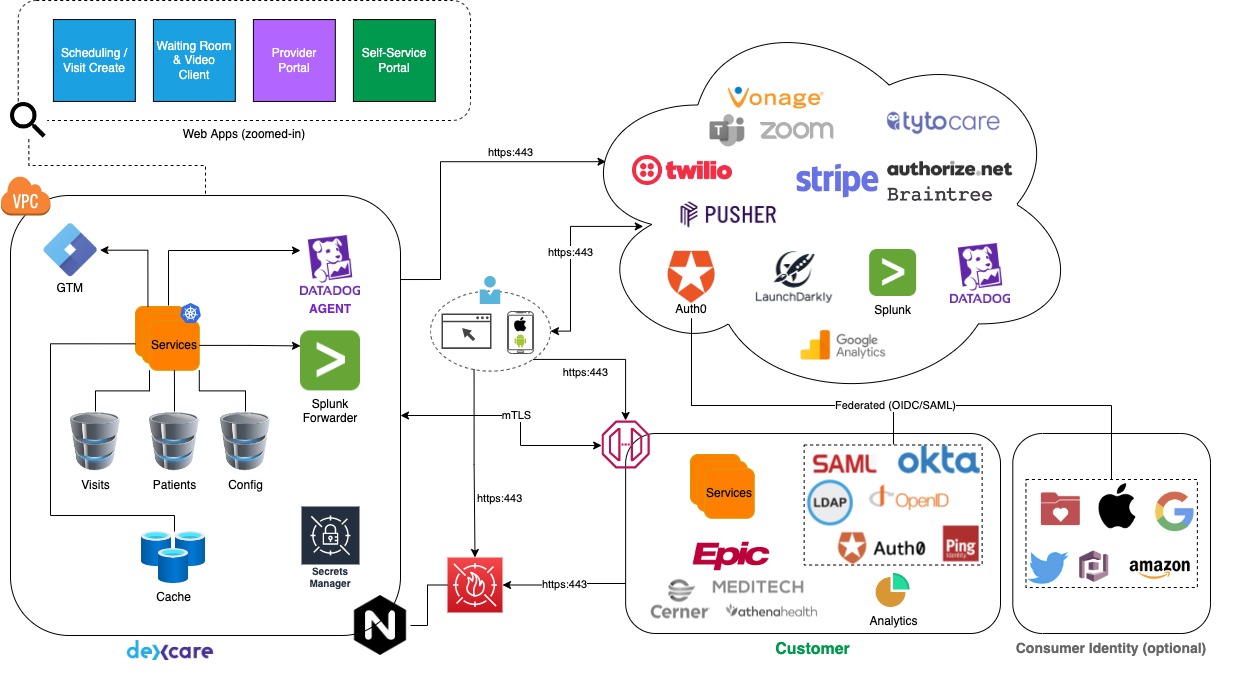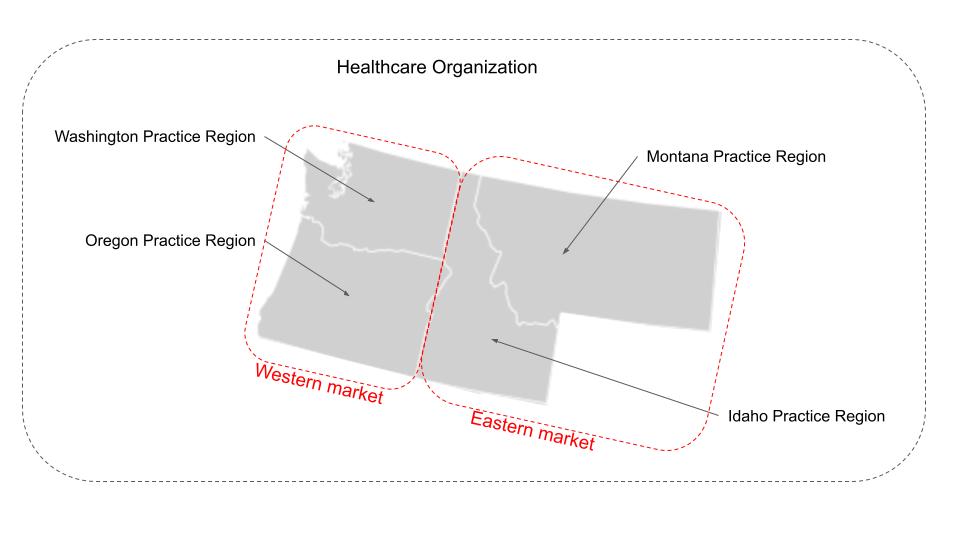Platform Concepts
This section is intended to provide high-level information needed to take best advantage of the DexCare APIs and SDKs.
DexCare is an intelligent platform that is focused on healthcare accessibility. To that end, the platform delivers services and value in three core areas:
- Care Discovery. Through its tight integration with customer EMR systems, DexCare has an accurate, real-time view into available care resources and schedules. With guidance provided by DexCare’s intelligent routing capabilities, patients can easily locate physical or virtual care from providers that have the specific expertise needed to address their needs, and confirm that care can be available in the patient’s desired timeframe. DexCare’s intelligent routing also optimizes healthcare system capacity by balancing utilization across providers and care locations.
- Care Booking. DexCare provides a customizable care booking workflows that can gather all of the necessary information in advance, saving time for both the patient and the provider. When the built-in capabilities aren’t enough, the DexCare APIs and SDKs can be used to create workflows that meet the healthcare organization’s specific requirements.
- Care Delivery. For on-demand virtual care, DexCare’s advanced telemedicine platform enables patients to easily join a care session, chat with staff to verify information and address any questions, and then work with a provider to resolve their healthcare concerns. DexCare’s discovery and booking features also work well with other existing telemedicine platforms.
You can learn more about the DexCare platform’s capabilities in the sections below.
Care Discovery
The DexCare platform supports patients where they are by helping them discover care resources via search, via healthcare system clinic and provider directories, or through its intelligent and optimized routing engine. The platform’s APIs and SDKs enable easy creation of consumer-friendly experiences to facilitate this discovery, enabling organizations across the healthcare spectrum to compose exactly the right process to connect patients to care.
Dexcare supports a variety of approaches to finding care based on a patent’s needs:
- If patients have a preferred care provider, the DexCare system enables them to check that provider’s availability and easily book the best time slot for them. DexCare calls this the provider-specific model.
- Often, patients do not have a preferred provider, do not know which facilities are nearby or might need in-person or urgent care. To support this provider-agnostic model and help patients obtain care from the first available provider, healthcare systems can use the DexCare platform to share nearby service locations, check schedules across different locations, and choose a scheduling option that meets the patient’s needs.
- When an in-person visit isn’t warranted or isn’t an option, a patient can easily check wait time for virtual appointments, then join a queue to see a provider in a video or voice session to get the care they need.
Care Booking
The DexCare platform supports convenient care booking through its scheduled and on-demand booking modes.
Scheduled booking is used for in-person or virtual visits on a particular date and time. Key use cases for scheduled booking include:
- Urgent care clinic appointments
- Provider-direct primary care provider appointments
- In-clinic or virtual appointments.
With the DexCare platform, you can use the discovery capabilities outlined above to find the optimal delivery location or modality, and then transition seamlessly into a built-in or customized booking experience. The built-in booking service provides a customizable, “white-label” patient experience, and the APIs and SDKs provide additional capabilities by enabling easy submission of:
- Patient and/or caregiver details
- Billing or payment info
- Visit details, both for the time slot and the purpose of the visit
- Acknowledgement / acceptance of care treatment or financial responsibility terms
On-demand virtual booking enables a “first come, first served” queued visit model. These virtual visits are always done via phone or video, and their scheduling is dependent primarily on the state in which the patient resides (or is currently located). Common use cases met by virtual scheduling mode include:
- Identifying virtual practice regions where services can be provided (usually based on provider licensure)
- Calculating estimated wait time for a virtual visit
- Invoking the built-in virtual scheduling and visit workflow
Care Delivery
DexCare provides a highly customizable telemedicine system that customers can use to quickly provide voice and video visit capabilities. DexCare’s system also supports additional features such as proxy booking, virtual hold with SMS and email support, provider and management portals, patient record creation, and a robust WebRTC-based video system. Using DexCare, administrative staff can interact with patients while they’re waiting to gather additional information, answer questions or provide other support.
If an existing telemedicine system is already in place, healthcare systems can still leverage DexCare’s discovery and booking capabilities.
System Architecture
The diagram below illustrates DexCare’s modular architecture.

Healthcare systems benefit from the platform’s close integration with EMR systems, and DexCare’s intelligent services, integrated caching and capacity management tools improve customers’ ability to manage both appointment slot inventory and provider utilization. Many of DexCare’s services are accessible via a collection of patient- and provider-facing web applications, and customized capabilities can be created using DexCare’s REST APIs or SDKs for iOS, Android and JavaScript.
DexCare works closely with a number of external services that provide secure, high-quality, highly-available capabilities for:
- video and telecommunications
- billing and financial integration
- authentication and authorization
- monitoring and management
- new feature deployment
- usage analytics
General Concepts
The concepts described below are integral to helping healthcare IT teams understand the DexCare APIs and SDKs.
Visit Types
In the DexCare system, a visit type represents a service that can be provided by the healthcare organization, either at a physical location or in a virtual visit. Visit types are defined by the healthcare organization, and can be used to denote services such as “new patient visit”, “illness”, “vaccination” and many others.
Time Slots
Time slots represent points during the work day during which appointments can occur. Time slots and their normal duration are retrieved from the EMR system in use by a particular department or practice region, and can be associated with particular visit types. A “new patient” visit, for example, can be scheduled for 45 minutes and occur only during certain parts of the day; an “illness” visit might be scheduled for only 30 minutes but occur at any time.
Scheduling Workflow
A scheduling workflow is the process by which a patient (or their parent, guardian or appointed delegate) schedules a visit. DexCare provides a customizable scheduling workflow, or the healthcare organization can define its own. During the workflow information is gathered about the patient and their healthcare needs, an appropriate appointment date and time is identified, and a new patient record is created in the EMR if requried.
For on-demand virtual visits, the scheduling workflow automatically places the patient into a virtual “waiting room”, allows practitioner support personnel to ensure that all patient-related information is gathered and verified, and allows the practitioner and patient to communicate in a secure manner.
Booking Concepts
Departments
Departments represent the physical locations at which services are provided and at which healthcare providers generally work. A department definition includes information about the physical location, such as its address or geographic location, its operating hours, the types of services it provides, and the EMR system in use by that location. Departments are always defined by the healthcare organization.
Brands
For organizations that operate multiple distinct healthcare systems, departments can be associated with a particular brand. This brand can be used to limit department search requests to a specific set of physical locations.
In-Person Visit Scheduling
Time-based healthcare appointments can be scheduled in either provider-agnostic or provider-specific resource modes. In provider-agnostic resource mode, the patient selects a physical location at which to receive services, and can then select a time slot but is unaware of the actual provider they will see. In provider-specific mode, the patient selects a time slot from a specific provider’s schedule.
The diagram below illustrates the relationship between the various concepts.

In this diagram, a major healthcare organization has two “brands” known to their target markets.
-
Brand A has two slot based locations (departments), each of which has two providers that are available to see patients (Drs. Smith and Martin in Department 1, and Drs. Jones and Marks in Department 2). Each provider has a separate calendar, and can only be scheduled directly (known in DexCare as “provider-specific scheduling”). All of the providers have some time slots available except for Dr. Marks, so when patients look for Dr. Mark’s availability no time slots will be shown.
-
Brand B has one slot based retail location. In this department, however, the providers are not scheduled directly; instead, the department uses a generic provider schedule that represents the available time slot capacity. A patient making an appointment at this location views this calendar for availability, and could be assigned to any provider working at this location. This is called “provider-agnostic” scheduling.
Virtual Visit Concepts
Practices
In on-demand virtual visit booking, a healthcare organization can define one or more practices. These practices can group practitioners by licensure, by specialty, or by any combination of characteristics. Practices are identified using a practice ID, which is a static identifier created when a new practice is defined. By default, the DexCare system provides a single default practice that covers all services areas for the organization.
Practice Regions
Unlike time-based booking, on-demand virtual booking is not associated with physical service locations. Instead, virtual scheduling relies on the concept of a practice region, which generally represents an area where the healthcare organization provdes services(usually a scope of licensure for one or more practitioners). A healthcare organization can have multiple practice regions, and these can be aligned with geographic boundaries (such as US state boundaries) or any other appropriate scope. Practice regions also define their available operating hours, the associated EMR system, the cost of a visit and other informtion necessary for scheduling.
Modalities
Wait time for on-demand virtual visits is assigned to the modality used to deliver the service. This can be a DexCare-defined modality (“phone” or “virtual”), or can be defined by the healthcare organization.
Assignment Qualifiers
In addition, wait time can be associated with assignment qualifiers. While not required for virtual visit scheduling, assignment qualifiers can be used to further distinguish wait times and modalities, and ensure that the patient is directed to the most appropriate practice region.
Markets
Sometimes, healthcare organization need even more control over practice region selection than practice regions and assignment qualifiers can provide. For virtual visits, DexCare support the concept of a market, which can be thought of as an “overlay” on top of practice regions. Markets can be used to further separate practice regions into separate areas of service, to define “primary” and “fallback” practice regions, or for several other purposes. If markets are not defined, each practice region is placed into its own “default” market.

The diagram above illustrates the various virtual scheduling concepts. It shows four states in the US Pacific Northwest that are all served by the same healthcare organization — Washington, Oregon, Montana and Idaho.
These four states are broken into two markets - the Western Market and the Eastern Market. Each state has a pool of providers licensed in that state, and some of those providers are also licensed in the other state(s) in their markets. Some Washington providers are also licensed in Oregon and vice versa, and some Idaho providers are also licensed in Montana and vice versa.
This market “overlay” could allow the organization to direct virtual visit requests first to the state in which the patient resides and then, if no provider in that state is available, to appropriately-licensed providers in another state in the same market.